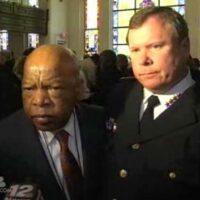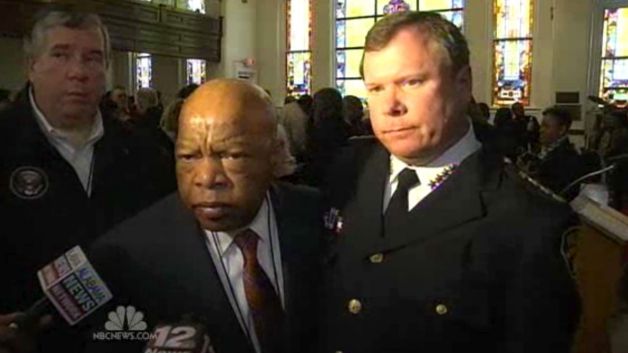The Montgomery Police Badge, the Harlem Shake, and Other Post-Pain Performative Gestures


Two recently televised events – Melissa Harris-Perry’s reaction, on her show, to the Harlem Shake dance craze, and Montgomery, Alabama Police Chief Kevin Murphy’s public apology to civil rights veteran Representative John Lewis – both caught my eye as being surprisingly relevant to the book project I am working on now regarding deadly prejudice in an entirely different historical and cultural context.
The puzzle I am grappling with in my own work is deeply personal. As a Polish-American anthropologist who has spent over a decade teaching college students about genocide and the Holocaust, I want to be critically honest about the sociological workings of anti-Semitism in Poland, particularly around the time of the Nazi occupation there. At the same time, however, I still want to nourish my family’s connection to, and pride in, the land of my ancestors.
Yes, it is certainly possible for me to point out to students the great number of Polish citizens who have been recognized as “righteous among Nations” by Yad Vashem for their courageous work trying to rescue Jews at a time when such activity was punishable by death. But this kind of countering of one type of response (brave selflessness) against its opposite (capitulation to evil) has always felt unsatisfying to me, especially since I know that such deadly prejudice does not simply disappear when the war has been won, or when civil rights legislation has been passed. Hence my special interest in the two recent YouTube-mediated events I mentioned above. Neither one seems to have been planned as “proof” or “contradiction” of anything.
Instead, both of them involve what I am interested in observing in a future trip to Poland: something that might be called “performative gestures.” These may be as simple as small objects or deliberate movements, loaded with significant meanings, given or enacted formally and publicly, or they may be a part of larger productions involving musical or dance creations involving the choreographed participation of entire ensembles of performers.
http://youtu.be/mIgzzHOQWiA
In respect to the first example cited above, let us pay attention to the way Harris-Perry contextualizes these kinds of performative gestures:
The Harlem Shake has a history and a trajectory embedded in the authentic, lived urban experience…. You have not seen the Harlem Shake unless you have seen kids on the New York Subway performing the intricate, fast-paced, and on-beat moves while maintaining balance on a moving train. Now this is about more than the proper designation of a popular dance. It’s about cultural appropriation. When communities create original art, they have a right to some sort of control over its definition… Creative interpretation is expected to respect certain boundaries. That’s what conveys the respect….. This is especially true with respect to the long history of voyeurism and appropriation of Harlem’s artistic innovations. Harlem has given birth to some of the nation’s most distinctive and original art – music and literature. And just as surely as Harlem has innovated, it has been invaded by those who come to Harlem with little sense of history or social context and no desire for political or economic solidarity. Think of the original Cotton Club of the nineteen twenties. There it sat on One Hundred Forty-Second and Lenox…. But only white patrons were allowed. No member of the community could sit and enjoy the music that the community itself created. And the wound of that cultural theft is still fresh. And the new Shake craze must be understood in that context.
As for the second event, the televised footage shows Montgomery, Alabama Chief of Police Kevin Murphy unpinning his police badge from his dress uniform and then, with even more deliberate movements than those enacted by the dance troupe, Chief Murphy respectfully places the badge into the hands of Congressman John Lewis. Representative Lewis was only a young man in his twenties in 1961, when he and the other Freedom Riders who had been peacefully demonstrating for civil rights throughout the South were brutally beaten by enraged mobs when they reached Montgomery, where they were given absolutely no police protection whatsoever during this attack.
Again, it is important to highlight the key words of this video, which focuses on Police Chief Murphy’s unexpected gesture at the end of a service at the First Baptist Church of Montgomery on March 3, 2013, held to commemorate the fiftieth anniversary of the Civil Rights Movement in the United States. The Alabama-born police chief apologized in this way to John Lewis for the inaction of the Montgomery police during the beatings and mob harassment which he and other civil rights leaders endured at that turbulent time:
When you got off the bus in 1961, you didn’t have a friend in the police department, and you were good friends with the president of the United States, and [taking off his badge] I want you to know that you have friends in the Montgomery Police Department, that we’re for you, we’re with you, that we want to respect the law, and adhere to the law, which is what you were trying to do all along. This symbol of authority, which used to be a symbol of oppression, is to be a symbol of reconciliation. Fifty-two years ago, what you stood for has made a difference. The world that we live in today, this city that I get to serve as police chief is changed for the better because … I wouldn’t be standing here right now if it weren’t for you. And this is a token of that appreciation, Congressman, because you changed this city, you changed this state, you changed this country, and as Paster Ward said, you’ve changed the world, and for that we are truly grateful to you.
As Police Chief Murphy later said about this incident,
I think what I did today should have been done a long time ago. It needed to be done. It needed to be spoken because we have to live with the truth and it is the truth.
And so we have, on the one hand, a rather gentle complaint by Melissa Harris-Perry about an instance of cultural appropriation (the media’s and the public’s ignorant rush to label any kind of post-Gangnam-style intricate dance moves as “the Harlem Shake” without really knowing or caring much about Harlem’s decades-long contributions to music and art, other than as something to be harvested and commodified by outsiders). On the other hand, we have a personally delivered apology from Police Chief Kevin Murphy for offenses perpetrated by “his people” (although he had not even been born yet) against John Lewis and the other Freedom Riders half a century ago.
How might these tangled threads — pain, injustice, cultural appropriation, possible attempts at reconciliation and repair — also be woven into the tapestry of my own writings-in-progress, at first glance so far removed in time and space from considerations of US racial history?
To be sure, the topic of Polish-Jewish interrelations, especially in respect to those horrific activities of the Holocaust that took place in Poland, is a minefield. Even if I were to live double a normal life span, and be perfectly fluent in Polish and other relevant European languages, I could not hope to plumb the depths of all the writing that has already been dedicated to the critical exploration of this issue.
Yet those two events I witnessed on TV in the past few days do indeed seem to have something to say to me about the object of my Poland research. What I aim to do in my own work is uncover some of the same reciprocal oppositions (injury/apology, denial/acknowledgement, despair/hope, gestures of the perpetrator generation/gestures of subsequent generations) that I briefly spotted in the two videos I referenced above. Polish history (like all complex, multicultural national histories) is not only about oppression, prejudice, war, and death, but also about humans striving for goodness, joy, love, and vibrant, creative life.
In this connection I will be looking at the performative meanings and gestures of just a few selected works of music created in the past forty years in Poland – from Henryk Górecki’s Third Symphony (Symphony of Sorrowful Songs) to some of the neo-klezmer music now being created by young, often classically trained, mostly non-Jewish musicians in Poland, to examples of “rootz” music created and performed by Polish groups in folk festivals throughout Europe, to co-creations of traditional Polish mountain music performed by Polish highlander musicians playing and singing alongside Jamaican reggae artists.
Not every Polish or Jewish or Polish-American person who reads what I expect to write about will agree with my trajectory of exploration. “Why do you pick at scabs?” I often hear, when I raise questions about anti-Semitism in Poland, or, in a US context, about racism or genocide or attempted ethnocide against Native people.
“I have to. I teach.” is my answer.
And yet the past is not all horror. Like the soft, green, flexible blades of spring grass that delicately emerge and then crack their way through concrete, joy keeps trying to emerge, even through the pain that has scabbed over. Flashes of beauty, humor, decency, humanity, harmony, ambiguity, dissonance, silence and sound … these too are raw materials that I hope will find their way into that tapestry.
